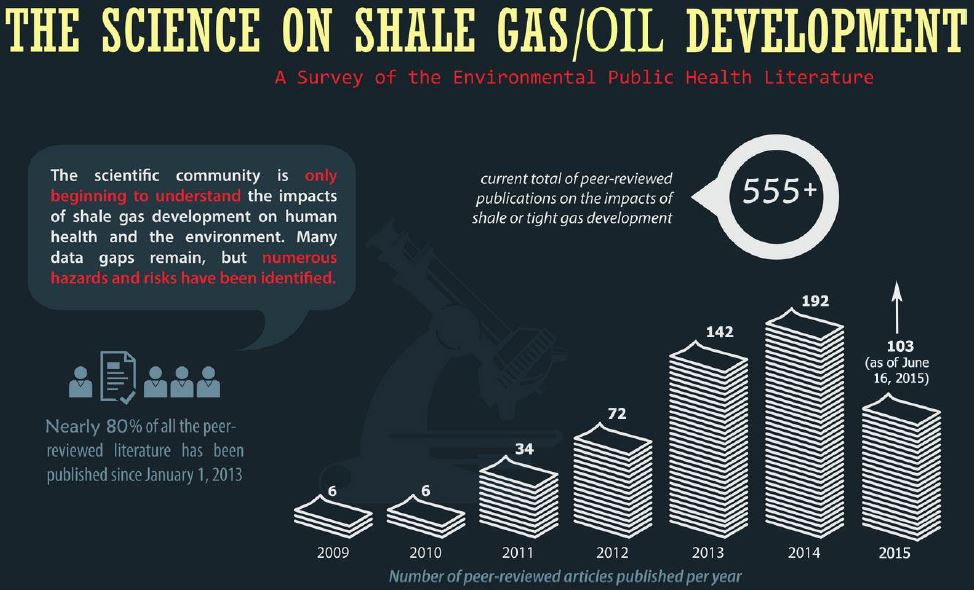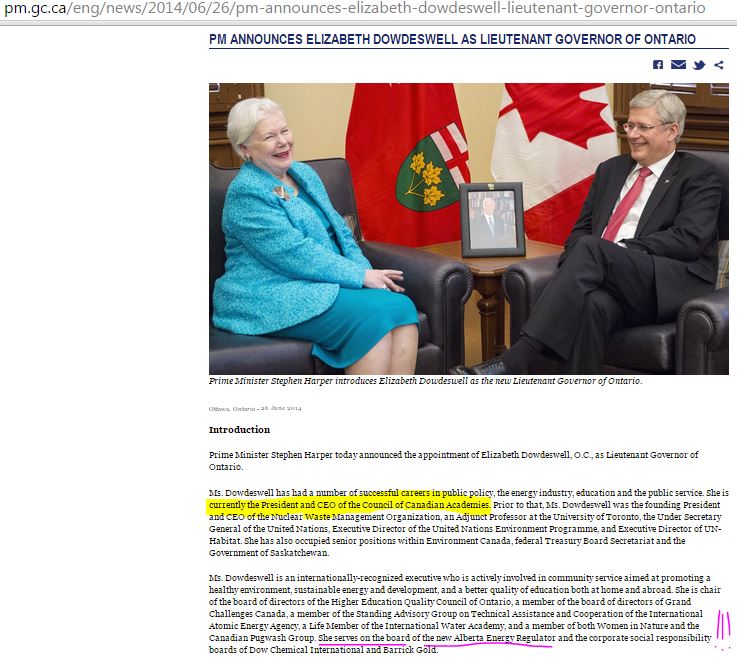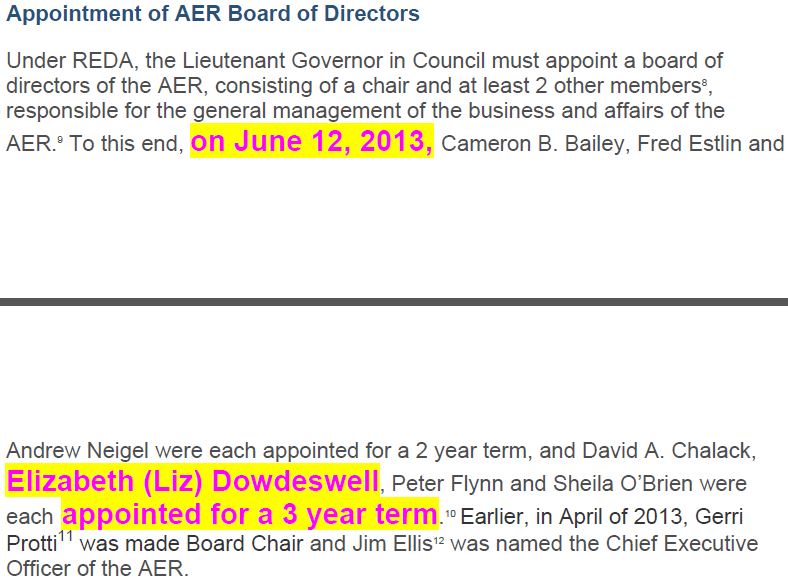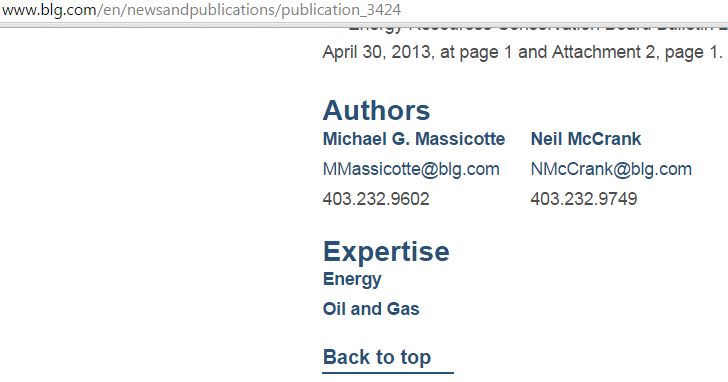Expert: More research needed on fracking’s impact by Andrea Gunn, June 14, 2015, The Chronicle Herald
The federal government needs to put its money where its mouth is when it comes to high-volume hydraulic fracturing, says one expert. John Cherry, a groundwater contamination specialist and the lead author of a 2014 Council of Canadian Academies [CCA] report on fracking, told The Chronicle Herald that if Ottawa is going to encourage fracking, it needs to start funding research that will give Canadians a clearer understanding of the environmental ramifications.
[Dr. Cherry needs to get caught up on his reading of peer reviewed research, already published, most showing harm and or risks to health and environment from fracing.
PDF compilation by BC Tap Water Alliance of the PSE Science on Shale Gas and Oil Development (excludes all on CBM) is now at >555 peer-reviewed, published papers.
Why isn’t Dr. Cherry chatting with the many frac harmed Canadians and Americans living frac’d without safe water? Industry and Harper won’t let him?]
Cherry said the science regarding almost every important question about the impacts of fracking is extremely limited.
He will be holding a talk at the University of King’s College in Halifax on Monday titled Hydraulic Fracturing: Should Nova Scotia Experiment?
“Right now, it’s not possible to determine whether the impacts will be significant or not,” Cherry said.
“We don’t even know at the present time how to even go about proper monitoring because there’s so little experience with it.”
He said he believes any province that has not embarked on fracking initiatives should hold off until more information about the potential effects is available. “There’s no rush to go ahead with shale gas development. It’s not like we’re short of energy.”
Several years ago, the federal government asked the Council of Canadian Academies to examine shale gas extraction, and in May of last year, the 260-page report Environmental Impacts of Shale Gas Extraction in Canada was released. The main finding of the panel of 14 experts that authored the document was that much more study is needed. The report highlights many gaps in research that prevent the scientific community from being able to dub hydraulic fracturing safe.
[The report and review panel “experts” including Cherry, ignored or cherry-picked from the masses of peer-reviewed research already complete and published, showing hazards and risks to health and environment from fracing. The panel also ignored vital data sent to them and ignored Health Canada’s 2012 report on fracing, completed two years before the CCA finished their report, that outlined significant risks to health and water. Why? Who does Dr. Cherry and his frac panel of “experts” work for? Harper, frac patent Dr. Maurice Dusseault and the oil, gas and frac industry?
And why, on June 12, 2013, was Elizabeth (Liz) Dowdeswell, when she was still president of the CCA, appointed to the Board of the AER (then ERCB) during the CCA’s frac review?
Where did Liz go? Why so soon? And why did the AER remove its posting of Elizabeth’s appointment to the Board? Too much conflict of interest, along with Gerard Protti’s?
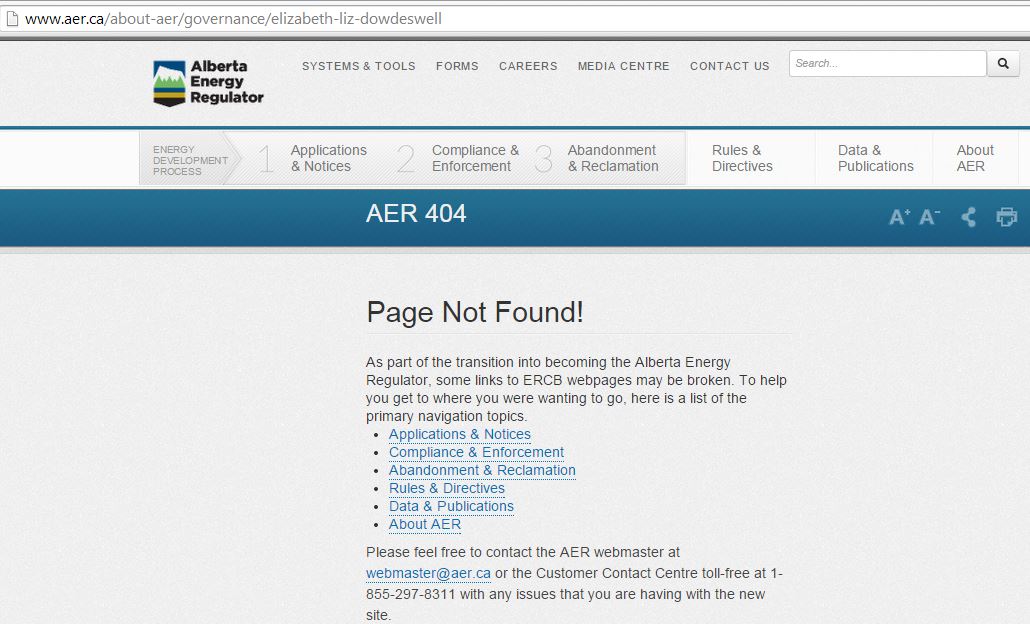
Above snap taken December 8, 2014 ]
This fall, Nova Scotia joined the long list of regions worldwide that have banned fracking over environmental concerns, although it has been slow in producing any concrete regulations.
The federal government has been supportive of fracking initiatives. In September, Joe Oliver, then the federal natural resources minister, criticized Nova Scotia’s ban, calling it a missed economic opportunity.
But Cherry said Ottawa’s sweeping support of fracking is irresponsible. “If they believe the provinces should be developing this resource, then it’s their mandate and obligation to put substantial research money into studying the environmental impacts of fracking.”
He noted that although the findings contained in his panel’s report emphasized the need for further investigation, the government has still not undertaken any initiatives to fund research. [Study the frac harms forever? Waste all that money? Why not put that endless cycle of go nowhere research money into installing energy systems that are not dangerous and polluting, and help communities and families?]
Although Nova Scotia has banned high-volume fracking for now, Cherry said it’s important to keep the conversation going. [Why? What’s in the propagandizing chatter for him? Shares in Dusseault’s frac patent?]
“All government bans only last as long as the government in power. There’s still a great economic interest by government and industry to go ahead with fracking.” [A LITTLE PROPAGANDA SLIPPING OUT .. AGAIN?]
His talk is free and open to the public. It will take place at 7 p.m. at the university’s new academic building. [Emphasis added]
[Refer also to:
BOARD MEMBERS…APPOINTED, AND TWO MORE REGULATIONS MADE — THE ALBERTA ENERGY REGULATOR HAS “OFFICIALLY LAUNCHED” by Michael G. Massicotte email hidden; JavaScript is required 403.232.9602 and Neil McCrank [Chair of the Alberta Energy and Utilities Board (1998 to 2007 – when the EUB was disbanded after spying, lying and law violation scandal] email hidden; JavaScript is required 403.232.9749, July 9, 2013, Borden Ladner Gervais LLP
Introduction
By News Release issued June 17, 2013 by the Alberta Energy Regulator (the “AER” or “Regulator”), notice was provided that the AER had “officially launched today after the Government of Alberta proclaimed the Responsible Energy Development Act, ushering in a new era in energy regulation.”1
In the June 2013 edition of this Oil and Gas Bulletin (found here), we discussed the proclamation of the Responsible Energy Development Act2 (“REDA”) as of June 17, 2013 (save and except for Part 3 and other specified sections), and the making of four Regulations under REDA.
As stated in that Bulletin, at this time, the new single regulator, the AER, has only assumed the energy development regulatory functions currently administered by the ERCB. The enforcement of “private surface agreements” under Part 3 of REDA will only become available, and the AER’s assumption of regulatory functions and responsibilities from AESRD under the Environmental Protection and Enhancement Act3, the Water Act4 and the Public Lands Act5, and from Alberta Energy under Part 8 of the Mines and Minerals Act6, will only occur, once the corresponding sections of REDA have been proclaimed in force.
As stated in the News Release, the launch of the AER on June 17 is “the first step in a [three- phase] approach towards full implementation of the AER with additional regulatory functions to be added over the coming months”.7 It is not entirely clear what steps will comprise the other two phases, although the proclamation of Part 3 of REDA and the sections dealing with the AER’s assumption of regulatory functions and responsibilities from AESRD and Alberta Energy, are expected to comprise one or both of these.
This Bulletin is intended to provide an update summarizing further developments in connection with REDA and the AER, including:
The appointment of the members of the AER Board of Directors;
The appointment of the chief hearing commissioner and other full time hearing commissioners; and The making of two new Regulations under REDA: the Alberta Energy Regulator Rules of Practice, and the Alberta Energy Regulator Administration Fees Rules.
Appointment of AER Board of Directors
Under REDA, the Lieutenant Governor in Council must appoint a board of directors of the AER, consisting of a chair and at least 2 other members8, responsible for the general management of the business and affairs of the AER.9 To this end, on June 12, 2013, Cameron B. Bailey, Fred Estlin and Andrew Neigel were each appointed for a 2 year term, and David A. Chalack, Elizabeth (Liz) Dowdeswell, Peter Flynn and Sheila O’Brien were each appointed for a 3 year term.10 Earlier, in April of 2013, Gerri Protti11 was made Board Chair and Jim Ellis12 was named the Chief Executive Officer of the AER.
As stated by Energy Minister Ken Hughes:
With these appointments, we have built a team that will truly usher in a new era of energy regulating for the province…This team, led by Board Chair Gerry Protti and CEO Jim Ellis, will ensure our province leads the country, and the world, in balancing resource growth with our strong environmental commitment.13
Appointment Of Hearing Commissioners
Under REDA, the Lieutenant Governor in Council must establish a roster of hearing commissioners consisting of a chief hearing commissioner and such other individuals as are appointed.14 To this end, on June 12, 2013, Bradley T. McManus was appointed chief hearing commissioner, and Alex Bolton, Robert C. McManus, Barbara McNeil and Christine Macken were each appointed “full- time” hearing commissioners for a 1 year term.15 It has been reported that part-time hearing commissioners will be appointed in the near future.16
A panel of one or more hearing commissioners selected by the chief hearing commissioner from the roster will conduct hearings of applications, regulatory appeals and reconsiderations under REDA.17
Two Additional Regulations Made Under REDA
In addition to the four Regulations identified in our June 2013 Bulletin18 (found here), by Ministerial Orders dated May 28, 2013, the Minister of Energy has made the following two new Regulations:
a) Alberta Energy Regulator Rules of Practice, Alta Reg 99/201319 (the “AER Rules of Practice”); and
b) Alberta Energy Regulator AdministrationFees Rules, Alta Reg 98/201320 (the “AER Administration Fees Rules”).
These new Regulations, each in force as of June 17, 2013, are similar to and replace the corresponding Regulations previously in place21 under the now repealed Energy ResourcesConservation Act22 (the “ERCA”).
a) AER Rules of Practice
While the AER Rules of Practice are similar to their predecessor in place under the ERCA23 (the “ERCB Rules”), there are some differences between them. What follows is a short summary of some of the more significant changes, as well as other commentary comparing the two sets of Rules.
i) Public Interest
Section 1 of the ERCB Rules provided as follows:
These Rules must be liberally construed in the public interest to ensure the most fair, expeditious and efficient determination on its merits of every proceeding before the Board.
Consistent with the removal of the reference to “public interest” in section 3 of the Responsible Energy Development Act General Regulation24, section 1 of the ERCB Rules has not re-appeared within the AER Rules of Practice.
ii) Standing and Rights Afforded an Intervener
In the November 2012 edition of this Oil andGas Bulletin (found here), we commented on the absence from REDA of the equivalent of section 26(2) of the ERCA, which affords a person standing where a decision on an application may directly and adversely affect the rights of that person.25
Section 34(2.1) of REDA, which was a late addition to the legislation26, provides that if the Regulator conducts a hearing on an application27, a person who may be directly and adversely affected by the application is entitled to be heard at the hearing. Under section 18 of the AER Rules of Practice, if the Regulator sets an application down for a hearing, the Regulator shall give a person who is entitled to be heard a reasonable opportunity of learning the facts bearing on the application, a reasonable opportunity to furnish evidence, an opportunity of cross-examination if the person will not have a fair opportunity to contradict or explain the facts or allegations in the application without cross examination of the person presenting the application, and an adequate opportunity of making representations in the Regulator’s presence.
These two sections largely contain the equivalent of old section 26(2) of the ERCA.
iii) New Deadlines
Consistent with the unprecedented level of sweeping regulatory reform at both the provincial and federal levels in the past year28, with the objective of streamlining the regulatory process for major economic projects, a number of time limits have been introduced in the AER Rules of Practice, including the following:
Under sections 28 and 35, the Regulator shall, within 90 days from the date of the conclusion of, respectively, a hearing of an application or reconsideration, make and publish a written decision; Under section 33, the Regulator shall, within 90 days from the date of the conclusion of a regulatory appeal, make and publish a written decision;
Under section 45, unless the Regulator permits otherwise, no party may file a document, statement of concern or submission after the time limit set out in the notice of hearing has elapsed; and Under section 53(1), unless the Regulator otherwise directs, if a party intends to present documentary evidence at an oral hearing or electronic hearing, or is directed to do so by the Regulator, the party shall file the documentary evidence and serve a copy of it on the other parties before the hearing takes place and in accordance with any time limits set out by the Regulator. Old section 17(3) of the ERCB Rules, under which parties were permitted to file documentary evidence after a hearing had begun, has not been re-introduced in the AER Rules of Practice, although presumably, the Regulator retains the ability to direct that this occur.
iv) Expert Witnesses
Under section 22 of the AER Rules of Practice, the Regulator may require expert witnesses from different parties to confer with each other in advance of the hearing for the purposes of narrowing issues, identifying points on which their views differ or agree and preparing joint written statements to be admissible as evidence at the hearing.
Under section 23 of the AER Rules of Practice: a) witnesses sitting as one or more witness panels may be directed to comment on the views of other witness panel members and to make concluding statements; b) with leave of the Regulator, witnesses may pose questions to other witness panel members; and c) on completion of the testimony of the witness panel, the witness panel members may be cross examined and re examined in the sequence directed by the Regulator.
No counterpart to either of these sections previously existed in the ERCB Rules.
v) Other Changes
Other changes and things of note include the following:
Under section 3(2) of the AER Rules of Practice, applications must now be served on:
the registered owner of the land on which the energy resource activity that is the subject of the application is or will be located29; and any other person that the Regulator requires,
as opposed to any person whose rights may be directly and adversely affected by a decision of the ERCB, which was formerly the case under the ERCB Rules30;
Sections 35, 36 and 37 of the ERCB Rules, allowing the ERCB to direct the parties to participate in a settlement meeting, and providing for the filing and acceptance or rejection of a settlement proposal, have not been re-introduced in the AER Rules of Practice;
Section 37(2) of the AER Rules of Practice, the equivalent of which did not exist under the ERCB Rules, addresses conflicts of interest of hearing commissioners by prohibiting any hearing commissioner having an interest in the subject matter of a hearing or other proceeding, whether directly or because of the hearing commissioner’s position, affiliation or involvement in or with an organization, firm or business, from participating in the panel of hearing commissioners that conduct the hearing or other proceeding; Under section 49(4)(a) of the AER Rules of Practice, the prerequisites for the granting of a request for confidentiality have been re-worded from the previous test under the ERCB Rules; and
Under section 59 of the AER Rules of Practice, the Regulator may award an advance of funds to a participant if the participant demonstrates not only a need for financial assistance to address relevant issues to the proceedings, which was the case under section 52 of the ERCB Rules, but also that the funds are required for reasonable costs directly and necessarily related to the proceedings.
b) AER Administration Fees Rules
In accordance with the Energy ResourcesConservation Board Administration Fees Rules, by Notice mailed April 30, 2013 to operators of facilities in the oil and gas, oil sands and coal sectors, an industry levy was charged to fund the revenue requirement of the Energy Resources Conservation Board (the “ERCB”) for 2013.31 The fees were allocated on an industry sector basis, and calculated having regard to the ERCB’s operational requirements for each sector. Payment was due May 30, 2013. Unlike prior years, where the ERCB’s annual costs were funded by both government and industry, its revenue requirement for 2013 (determined to be almost $155 million) was funded solely by industry, in accordance with announcements made by the Government of Alberta in its 2013 Budget.
Following the proclamation of REDA on June 17, 2013, an assessment of the funding requirements for the operations of the AER must now be determined and all of the ERCB’s funding transferred to support the AER’s operations.32
Apart from adding “all wells categorized by the Regulator as commingled at December 31 of the base year” to the list of excepted wells in section 3(4)(d), and providing in section 8(7) that the Regulator may conduct the hearing of an appeal from a notice of an administration fee “orally, including by telephone, or in writing”, there are no changes of significance to the AER Administration Fees Rules, relative to the predecessor Regulation under the ERCA.
We intend to continue monitoring and reporting on further developments with the AER.
1 AER News Release, June 17, 2013 (the “News Release”), which appeared on AER letterhead containing its new web address: www.aer.ca.
2 Responsible Energy Development Act, SA 2012, c R-17.3.
3 Environmental Protection and Enhancement Act, RSA 2000, c E-12.
4 Water Act, RSA 2000, c W-3.
5 Public Lands Act, RSA 2000, c P-40.
6 Mines and Minerals Act, RSA 2000, c M-17.
7 AER News Release, June 17, 2013.
8 EDA, section 5(1).
9 REDA, section 6(1).
10 Order in Council 174/2013.
11 In the News Release, Gerry Protti is quoted as stating:
This new structure will allow the regulator’s Board of Directors to set the direction for the organization’s business, approve regulatory change, and set performance expectations for the regulator…The Alberta Energy Regulator board will operate as a corporate-style board.
12 In the same News Release, Jim Ellis is quoted as stating:
We look forward to working with the Government of Alberta to ensure we manage the transition to a new regulator in a manner that is strategic and practical, balancing the need for consistency and regulatory certainty while bringing new environmental regulatory responsibilities into the AER…This is an exciting time for energy development in Alberta, [ya, fracing free for all and all the water companies want] and we believe that the Alberta Energy Regulator marks an exciting change that will make a difference in the way we conduct our business and deliver results [unmitigated noise, road impacts, dust, health harm and contaminated water, for free] for Albertans…Albertans can be assured that the regulator’s highly trained technical staff remain dedicated to public safety, environmental protection, and conservation of our hydrocarbon resources throughout the transition.
13 CTV Calgary, “Alberta Energy Regulator fills board positions”, June 12, 2013.
14 REDA, section 11(1).
15 Order in Council 175/2013.
16 CTV Calgary, as www.ctvcalgary.ca, “Alberta Energy Regulator fillsboard positions”, June 12, 2013.
17 REDA, section 12(1). See also sections 12(2) and (3), and 13 of REDA.
18 Miscellaneous Corrections (Alberta Energy Regulator) Regulation, Alta Reg 89/2013; Responsible Energy Development Act General Regulation, Alta Reg 90/2013; Security Management for Critical Upstream Petroleum andCoal Infrastructure Regulation, Alta Reg 91/2013; and Responsible EnergyDevelopment Act Transition Regulation, Alta Reg 92/2013.
19 M.O. 62/2013.
20 M.O. 61/2013.
22 Energy Resources Conservation Board Rules of Practice, Alta Reg 98/2011 and Energy Resources Conservation Board Administration Fees Regulation, Alta Reg 114/2008.
23 Energy Resources Conservation Act, RSA 2000, c E-10.
24 Energy Resources Conservation Board Rules of Practice, Alta Reg 98/2011. 24 Responsible Energy Development Act General Regulation, Alta Reg 90/2013.
25 See our June 2013 Bulletin (found here) under b)(i) Section 3 – Public Interest. 25 BLG Oil and Gas Bulletin, November 2012 edition, at page 2.
26 REDA was amended November 7, 2012, before Bill 2 received Third Reading on November 21, 2012.
27 Notwithstanding that sections 7(1) and (2) of the AER Rules of Practice use the word “may” as opposed to “shall”, the net effect of these sections, similar to that under section 24 of the ERCB Rules, appears to be that a hearing must be set down if: a) a person files a statement of concern within the time set out in the notice of application; b) the person filing the statement of concern has demonstrated that they may be directly and adversely affected by the application; c) the Regulator does not consider the statement of concern to be frivolous, vexatious or without merit; and d) the Regulator determines that the objection raised in the statement of concern has not been addressed. See also sections 32, 33 and 34 of REDA, and sections 5 and 6 of the AER Rules of Practice.
28 See our January 2013 Bulletin (found here) for a summary of these reforms.
29 AER Rules of Practice, section 3(2). See section 48(1)(b)(ii) of the AER Rules of Practice for direction as to the manner of service of a document on a registered owner of land.
30 ERCB Rules, section 20(3).
31 As in past years, in response to a request by the Canadian Association of Petroleum Producers (“CAPP”) and the Explorers and Producers Association of Canada (“EPAC”), the administration fee process was also used to collect almost $2.4 million (payment of which is voluntary) to fund “broad industry initiatives” for 2013, deemed to be of general benefit to the upstream oil and gas industry (the funds were passed through to CAPP and EPAC, and used to fund non-oil sands initiatives determined by a panel comprised of CAPP and EPAC board members).
32 Energy Resources Conservation Board Bulletin 2013-16: 2013 ERCB Administration Fees (Industry Levy), April 30, 2013, at page 1 and Attachment 2, page 1.

